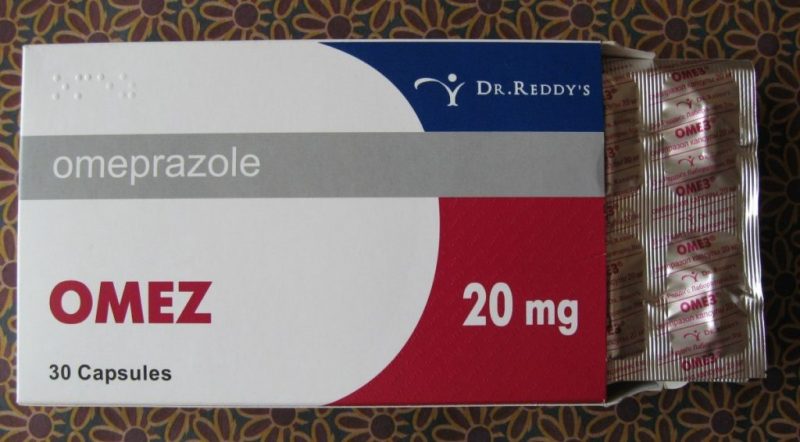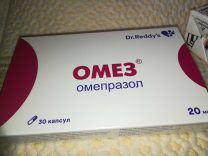Gastrointestinal diseases due to the high acidity of the digestive juice have been more and more common in recent years. In the treatment of such ailments, it is important not only to temporarily neutralize the irritating effect on the mucous membrane, but also to eliminate the cause of the high acidity of the stomach. A reliable and effective remedy for the treatment of gastrointestinal diseases is Omez, the instructions for use of which are described in detail below.
Material Content:
- 1 Release forms and composition
- 2 Pharmacological properties and pharmacokinetics
- 3 Why is Omez prescribed
- 4 Instructions for use and dosage
- 5 During pregnancy and lactation
- 6 Drug interaction
- 7 Omez compatibility with alcohol
- 8 Contraindications, side effects and overdose
- 9 Drug Analogs
- 10 Which is better, Omez or Omeprazole - expert opinion
Release forms and composition

Omez is available in India in the form of small enteric capsules packaged in foil blisters and packaged in cardboard boxes of 10, 20 or 30 pcs. The pills are transparent, they consist of two parts, one of which is colorless, the other pink or purple, depending on the dosage. On both halves there is an inscription "OMEZ". Inside there are white or yellowish granules.
The active substance of the drug is omeprazole. One omeza capsule may contain 10, 20, or 40 mg of active ingredient. But dosages of 10 and 40 mg are almost never found in the pharmacy market at the present time.
As auxiliary components in the medicine are present:
- gelatin;
- dyes and pigments;
- hypromellose;
- povidone;
- magnesium stearate;
- milk sugar;
- sucrose;
- water and others.
And also "Omez" can be found in the form of a lyophilisate (a kind of powder), from which a solution for infusions (droppers) is prepared. The product is packaged in small containers of 40 mg glass and placed in a cardboard box.As auxiliary components, the medicine contains disodium edetate and sodium hydroxide. The preparation of the dropper solution and the procedure should be carried out by medical personnel.
Pharmacological properties and pharmacokinetics
"Omez" is an antiulcer drug whose active substance (omeprazole) reduces gastric secretion. Its therapeutic effect is based on the inhibition of a proton pump or a specific enzyme H + -K + -ATPase.
As you know, the digestive juice of the stomach contains hydrochloric (hydrochloric) acid, which consists of hydrogen and chlorine ions. It is formed in the parietal cells of the stomach with the participation of H + -K + -ATPase, which is responsible for the transfer of the hydrogen ion - the final phase of the secretion of hydrochloric acid. Omeprazole deactivates the enzyme, preventing the final stage and reducing acidity in the stomach.
The medicine normalizes both basal and stimulated production of gastric juice. When taken regularly, it reduces the production of hydrochloric acid. A pronounced therapeutic effect is achieved on the 4th day of therapy. And also the drug shows some activity against Helicobacter pylori.
Features of the pharmacokinetics "Omez":
- quickly absorbed in the intestines;
- communication with blood proteins about 95%;
- the maximum content in the blood is reached after 30-60 minutes after administration;
- bioavailability is 30-40%;
- biotransformation occurs in the liver.
Biotransformation products are mainly excreted in the urine, partly in the bile.
Why is Omez prescribed
"Omez" is used for gastrointestinal diseases and temporary dyspeptic disorders caused by high acidity (heartburn, belching and others).
It is interesting:belching after eating

Indications for the prescription of the drug:
- stomach ulcer and duodenal ulcer;
- gastroesophageal reflux (irritation of the walls of the esophagus caused by regular throwing of the contents of the stomach into it);
- Zollinger-Ellison syndrome (an increase in acidity in the stomach caused by a tumor in the pancreas);
- gastrointestinal tract diseases associated with Helicobacter pylori (used with antibiotics);
- prevention of ulceration of the gastrointestinal mucosa with prolonged use of non-steroidal anti-inflammatory drugs (diclofenac, ketoprofen and others);
- prevention of Mendelssohn syndrome (ingestion of gastric contents into the respiratory tract) with general anesthesia.
Also, the drug is often used for pancreatitis in complex treatment (to relieve inflammation and facilitate the work of the pancreas), heartburn and other episodic manifestations of dyspepsia.
Instructions for use and dosage
Capsules are drunk half an hour before a meal.
The dosage and frequency of taking "Omez" depend on the purpose of therapy and the characteristics of the course of the disease:
- For the treatment and prevention of exacerbations of peptic ulcer, gastroesophageal reflux, and prevention of ulceration of the mucosa with NSAIDs, the drug is usually prescribed in a daily dose of 20 mg. In severe cases, an increase of up to 40 mg is allowed. The course of treatment can last from 2 to 8 weeks, depending on the characteristics of the pathology.
- With Zollinger-Ellison syndrome, the drug is drunk at 60 mg per day. It is allowed to double the dose with its division into 2-3 doses.
- To prevent the ingestion of gastric contents into the airways during general anesthesia, Omez is taken in a dosage of 40 mg before surgery.
- The dosage for the treatment of diseases associated with Helicobacter pylori depends on the type and dosage of antibiotics used in combination with Omez.
With episodic dyspeptic manifestations against a background of increased acidity (heartburn, sour belching), 20 mg is allowed if necessary.
Attention! Before taking Omez, you should consult your doctor.
During pregnancy and lactation
"Omez" is prescribed during the period of bearing a child and lactation after consulting a specialist.As studies have shown, the active component of Omez in the prescribed amounts does not adversely affect the fetus or newborn. Although this substance is found in breast milk.
Drug interaction
Studies have shown that Omez can enter into some interactions with other means:
- reduces the bioavailability of drugs whose absorption is affected by acidity in the stomach (some antifungal, erlotinib, iron preparations, vitamin B12);
- reduces the concentration of drugs for the treatment of HIV infection (nelfinavir, atazanavir) in blood plasma;
- increases the bioavailability of digoxin;
- reduces the therapeutic effect of clopidogrel;
- may increase the plasma concentration of tacrolimus, methotrexate, warfarin, hexobarbital and other substances whose biotransformation is carried out in the liver under the influence of the CYP2C19 isoenzyme;
- clarithromycin and erythromycin increase the content of the drug in the blood;
- rifampicin, preparations of St. John's wort perforated reduce the concentration of the drug.
Omez compatibility with alcohol
Any specialist will recommend to refrain from drinking alcohol during therapy. This will significantly increase the load on the liver, as ethanol and omeprazole are metabolized in this organ. In addition, the use of alcoholic beverages in diseases of the gastrointestinal tract can significantly aggravate the course of the disease and lead to serious consequences.
Contraindications, side effects and overdose
Omez tablets are not used for intolerance of its components and in persons under 18 years of age. Simultaneous administration with Erlotinib, Posaconazole, and drugs for the treatment of HIV infection is unacceptable.
When taking Omeza, the following side effects can very rarely occur:
- a decrease in the number of leukocytes, platelets, eosinophils in the blood, anemia in children;
- allergic reactions (Quincke's edema, urticaria, etc.);
- decrease in the amount of magnesium, sodium in the body;
- sleep disorders, confusion, depression, hallucinations;
- dizziness, migraine, lethargy;
- visual and hearing impairment;
- bronchospasm;
- abdominal pain, disorders of the stool, increased gas formation, nausea, vomiting, dry mouth, inflammation of the oral mucosa, the appearance of glandular cysts (with long-term use in combination with clarithromycin);
- hepatitis, liver failure;
- arthralgia, myalgia, predisposition to bone fractures on the background of osteoporosis;
- inflammation of the kidneys, gynecomastia, sweating.
Overdose "Omez" is manifested by headache, impaired consciousness, dry mouth, nausea, heart rhythm disturbance, increased heart rate. The treatment is symptomatic.
Drug Analogs
In addition to the usual "Omez", several more of its varieties are produced:
- Omez Insta, powder. The form is diluted with water and taken orally. 1 sachet of the product contains 20 mg of omeprazole.
- "Omez D" capsules. A combined drug whose active ingredients are omeprazole (10 mg) and domperidone (10 mg). The latter is used for dyspeptic symptoms (nausea, bloating, flatulence and others).
- Omez DSB, modified release capsules containing 20 mg of omeprazole and 30 mg of domperidone.
Omez has several complete encapsulated analogues containing 10 or 20 mg of omeprazole each:
- "Omeprazole" (depending on the manufacturer, the name of the medicine may differ slightly, for example, "Omeprazole-Teva" or "Omeprazole Sandoz");
- Ultop (Slovenia);
- Gastrozole (Russia);
- Losek (Sweden);
- Promez, Romesek (India).
Analogs of Omeza vary in price and composition of the components necessary for the correction of color, taste and shape.
Which is better, Omez or Omeprazole - expert opinion
“Omez” and “Omeprazole” are generics of the Swiss original drug “Losek”. They contain the same active substance and are somewhat different in the composition of excipients, so they are interchangeable.Despite this, many gastroenterologists prefer to prescribe Omez to patients, since, in their opinion, it is less likely to cause side effects.















